Jean-Pierre Datcharry is renowned for being a specialist in organizing camel caravan crossings of Morocco. With his agency Désert et Montagne Maroc, he has settled in a small village near Ouarzazate. Several times a year, he travels with hikers across the country to discover its beauty and diversity. Naturally, during his travels, he encountered nomadic shepherds from southeastern Morocco and established a continuous relationship with them and their families. Like many others, he has observed the decline of the mountain shepherd profession and shares his views on the solutions to be implemented to prevent the eventual disappearance of this traditional and ancestral figure in Morocco.
Jean-Pierre Datcharry – My encounter with the shepherds and their families took place among the nomadic tribes of the Aït Atta confederation passing through the territory of Aït Bouguemez. At that time, 37 years ago, I lived in a small village at the top of the Aït Bouguemez valley. I was a mountain guide working for travel agencies based in Marrakech or France.
I enjoyed meeting this community and once accompanied one of their transhumances, which allowed me to discover them intimately in their daily lives. It was then that I organized my first hike with a group of foreign travelers along a transhumance route, following one of the families as they moved with their herd. The quality of the experience lived by these travelers led me to repeat this type of hike every year, for the past 35 years.
Jean-Pierre Datcharry – The nomadic Aït Atta tribes’ original territory is the Djebel Saghro massif, although they have also extended southward into the Drâa Valley or northward into the Atlas Mountains, particularly concerning the Aït Atta Oumalou tribe.
The djebel Saghro : (or Adrar Saghru in Amazigh) is a mountain in southern Morocco, reaching an altitude of 2,712 meters. It is located east of Ouarzazate, 70 km south of the Central High Atlas, overlooking the Drâa valleys to the west and south, and the Dadès valley to the north. It forms the eastern part of the Anti-Atlas. / Source : Wikipedia
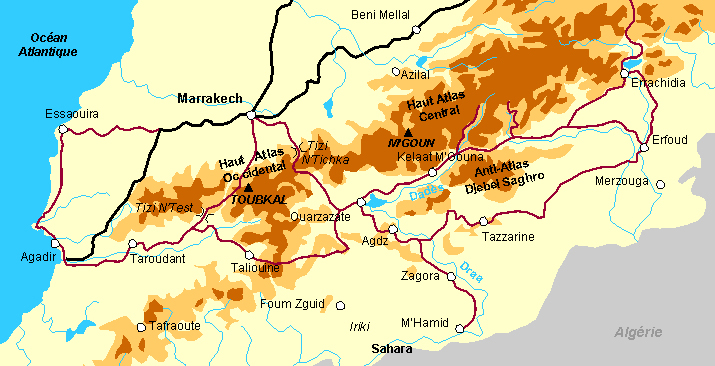
Part of the Aït Atta tribe once established agreements with the tribes of the Aït Bouguemez valley to use their mountain pastures during the summer on the northern slopes of the High Atlas, beyond the M’Goun Massif, territories with a milder climate than those of the Djebel Saghro. These pastures were already occupied by the herds of the Aït Bouguemez communities themselves, as well as by families of the Aït Mohammed located further north.
It is important to understand that there was a time when all these tribes were in conflict, even quasi-war, particularly over pasture issues. Each had their strengths, but the Aït Atta tribes were renowned for their vigorous fighters. A pacification of these disputes was achieved in the 1940s under the auspices of the French authorities of the Protectorate then in force in Morocco since 1912. An agreement was thus signed in the small town of N’Kob between the parties involved.
This allowed Aït Atta shepherds and their herds to engage in transhumance with the Aït Bouguemez, venturing to the verdant slopes of their territories. In exchange, the Aït Bouguemez tribes were invited to spend the winter in the mountains of the Djebel Saghro, with the Aït Atta, thus leaving the harshness of the snow for the milder temperatures near the Sahara.
And to this day, these cross-transhumance movements of shepherd families and their herds take place every year. Given the success of this activity among Morocco-loving hikers, I also organize a second hike for the return journey of the Aït Atta herds, in the fall.
Jean-Pierre Datcharry – The Aït Atta herds are allowed to settle on the pastures of the Aït Bouguemez from June 1st of each year until the arrival of snow. The grazing area is called Tamda and is also located near Lake Izourar.
It should be noted that the month before the arrival of the herds, in May, the pastures are guarded by a group consisting of the three communities involved, the Aït Bouguemez, the Aït Mohamed, and the Aït Atta, to ensure that no shepherd comes to settle with their animals.
For the herds from the Aït Bouguemez valley, there is no specific date for their presence, as the territory of the Aït Atta is vast.
As for me, I organize my hikes to follow the transhumances in May, in order to arrive on the destination lands at the desired time. We usually arrive at the entry point a few days before the opening date. Therefore, we make a bivouac stop at the foot of the Tizi n’Tighrist pass (2600 m altitude).
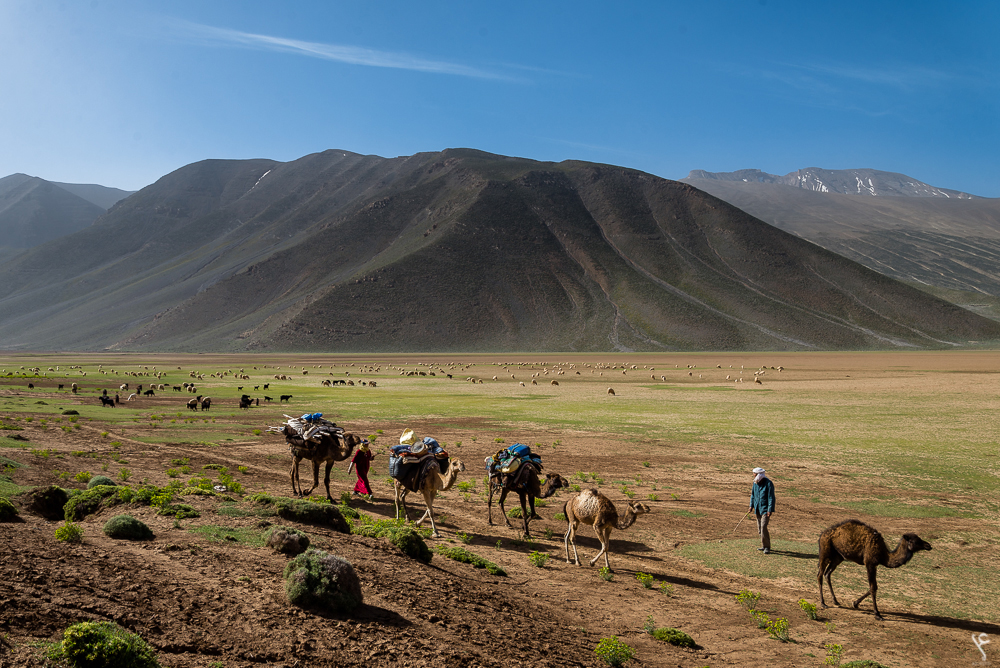
Today, there are fewer than ten small-sized herds
In the past, grazing areas made available for the Aït Atta herds were allocated by lottery among each tribe. It should be noted that in those distant times, nearly 50 tribes, and therefore 50 herds of over 600 head each, would gather to benefit from the more favorable territories of this valley. Today, there are fewer than ten small-sized herds, totaling around 150 head, that make this transhumance journey each year. This year, we only encountered six families, three fewer than the previous year, and the tribe we were accompanying sold all their sheep during the journey, taking advantage of an encounter with a livestock dealer.
Jean-Pierre Datcharry – This movement of disappearance began about a decade ago and proves to be inevitable. Nomadic families no longer tolerate their ancestral way of life. Living conditions are indeed too harsh, and the nomadic lifestyle is no longer accepted by women or the younger generations who see the allure of modernity surpassing the qualities inherent in nomadic life.
Another factor contributing to the abandonment of this activity is the fragmentation of herds with each inheritance division after the death of a tribal leader. The smaller the herds become, the less capacity there is to generate income sufficient to meet the growing needs of life. And there are fewer people available to take care of the animals, as was once the case with children and youth who quickly took part in collective work.
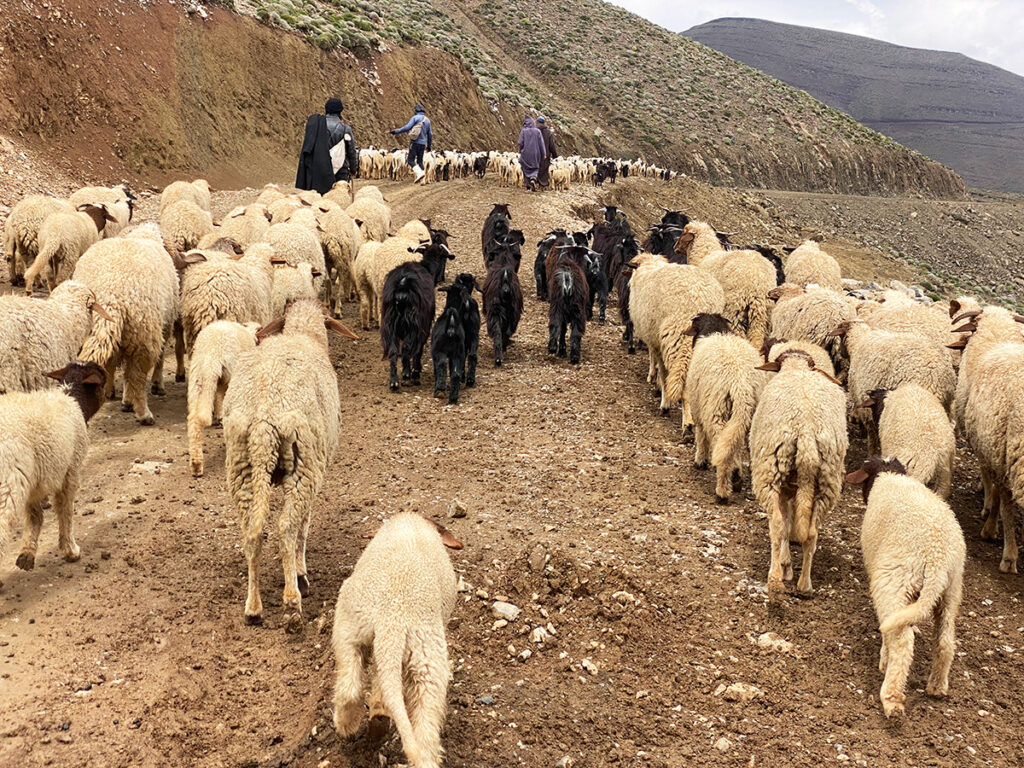
Jean-Pierre Datcharry – The solution, in my opinion, would be to pool the herds among families that have become smaller than the large tribes of the past. I have often proposed this idea to the nomads I meet. Indeed, if each family brings their sheep to form a large herd, its management throughout the year will become easier and, above all, more profitable. Family heads could take turns caring for the animals, allowing for other complementary economic activities. Families could then settle in towns, as many already do in N’Kob, thereby facilitating the education of children and access to basic public services.
To be honest, this proposal has little resonance among them. Most of them have already decided to quit their shepherd profession.
They have lost the flavor of their own identity as shepherds and nomads
Jean-Pierre Datcharry – A few years ago, efforts were made by the authorities such as the construction of tracks and the installation of water points, but this seems too late or insufficient.
Faced with the disengagement of nomadic shepherds from their traditional way of life, the real challenge is no longer just logistical but lies in the revaluation of this tradition, which is now endangered. While pooling resources and means logically appears as the solution to rationalize and therefore revive this economic activity, it must be understood that these shepherds no longer have the strength or even the confidence to organize themselves and together try to perpetuate this way of life.
They have lost the flavor of their own identity as shepherds and nomads and wish for a completely different life for their children.
Jean-Pierre Datcharry – Above all, we need to work towards raising awareness within Moroccan society regarding the disappearance of one of Morocco’s oldest traditions. The initiative launched by the Moroccan NGO We Speak Citizen to establish a Shepherd’s House in the Aït Bouguemez Valley is a step in this direction, as shedding light on the reality of mountain shepherds will lead to a better understanding of the nature of the challenges they face.
It will then become clear that enhancing their social status in Morocco as nomadic shepherds is a crucial element for the survival of their profession.
Further reading : The shepherd, the forgotten pearl of Moroccan cultural heritage
It would also be necessary for a major NGO specializing in agricultural issues to get involved in supporting the shepherds to help them move towards this essential mutualization, thus ensuring that each group has greater strength to improve their working and living conditions, to allow for better preservation of breeds, better management of movements, and greater commercial strength to set their prices.
For many years, Morocco has expanded the use and development of cooperatives, especially in the agricultural and artisanal sectors, but it must be recognized that this organizational tool is not suitable for the nomadic shepherd population. Another mode of organization, one that is more flexible, closer to the realities on the ground, and more in line with the mindset of these individuals who are inherently drawn to space and freedom, needs to be invented.
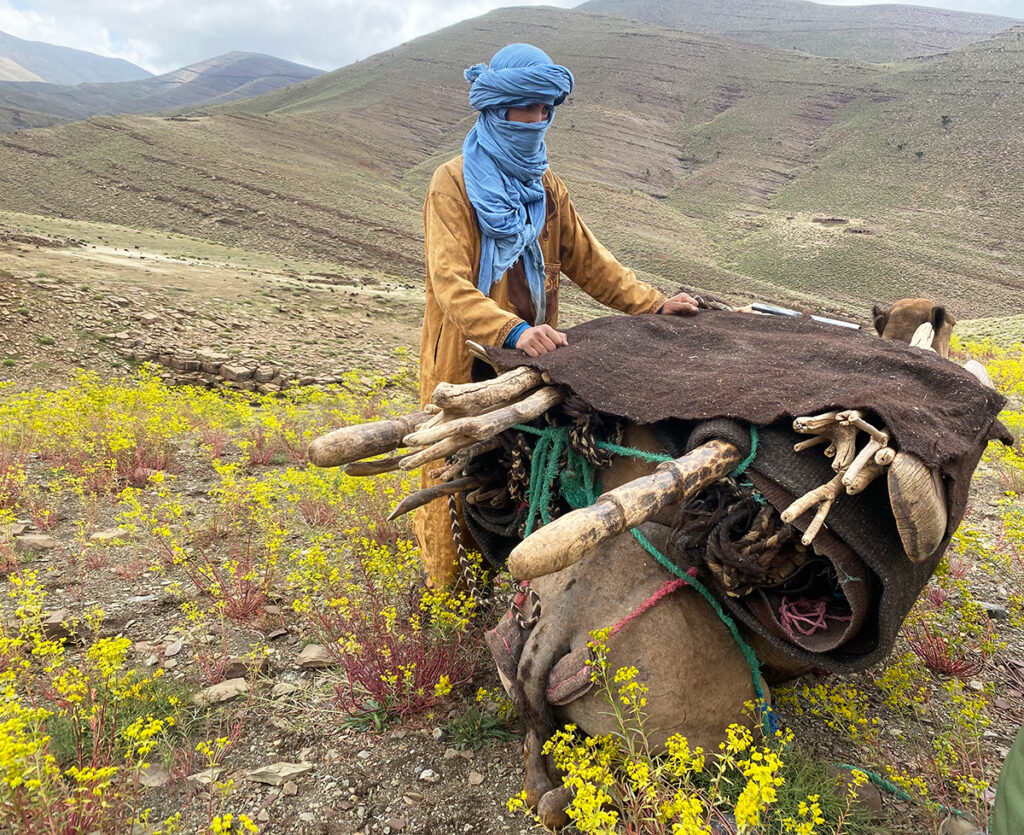
Establishing a quality label for the meat of these sheep is a priority
Jean-Pierre Datcharry – Of course, it works in France, and it can work in Morocco. It’s important to keep in mind that the sheep market is very significant in Morocco. Specifically, during the last Eid al-Adha, Morocco imported nearly a million sheep from Spain with a subsidy system. Meanwhile, we see all these nomadic shepherds, especially the youth, leaving their profession to take on menial jobs.
This sheep market generates significant revenue, and it should also benefit the traditional shepherds of the mountains. If we manage to truly highlight the quality of the meat from sheep raised in mountain pastures, animals that have fed on thyme, wormwood, and other mountain plants, then we can establish higher selling prices.
The solution of a quality label for the meat of these sheep, something like “Atlas Morocco Sheep,” should again be a priority for Moroccan authorities, and I am certain that there are consumers in the major cities of the country willing to pay more for the meat they eat, as is already the case for farm chickens or eggs, if they are assured of the territorial origin of the sheep and their full growth in pastures.
Therefore, it requires the mobilization of several stakeholders around this challenge of keeping the mountain shepherd profession alive. It’s about preserving a figure of Moroccan heritage.
Supporting the mutualization of shepherds should allow for the sedentarization of families. Let’s accept the idea that the shepherd’s family settles permanently so that women and children can access more acceptable living conditions today. Each family pools its animals, and only the men continue their nomadic lifestyle, joined by young people who will then choose to become shepherds.
Finally, the establishment of a real social status with health coverage and retirement benefits will be a significant advancement that will motivate the younger generations to continue the path of their parents.
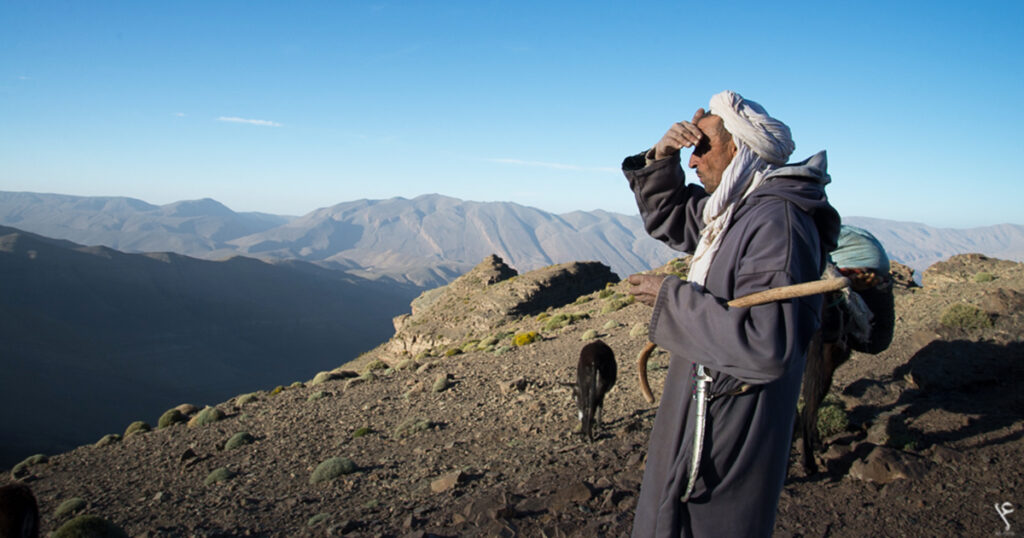
The shepherd resonates within us an essential part
Jean-Pierre Datcharry – At my modest level, aside from the advice I try to share with them, there isn’t much I can do. Certainly, for many years, the transhumance treks I organize have provided income for some of these nomadic families we follow, and I have often recruited young people from these tribes to work as camel drivers or guides within my agency, Desert and Mountain Morocco.
However, and perhaps most importantly, through the organization of these annual treks to follow the transhumance of the herds, I seek to raise awareness among foreign and Moroccan travelers about the unique existence of these shepherd families, still somewhat nomadic, and representing one of the beautiful facets of Morocco.
I have observed that those who experience these transhumance treks, spending a few days immersed in the life of these mountain shepherd families, leave amazed and deeply touched.
Perhaps it is because the shepherd and the nomad carry within them something that resonates with us, something essential, a truth about ourselves; perhaps it is the trace, the memory of our origins, or maybe it is something that speaks to our future.
Watch this








3 responses
One year, in spring, we had the privilege of accompanying a nomadic family on this transhumance and were able to witness the very difficult living conditions of the nomads. One can easily understand their desire to have a life more in line with our time and their willingness to settle down. As for the rest, Jean Pierre is absolutely right about the solutions to undertake.
The topic is very broad and holds great symbolism for all the ancestral activities in the life of Moroccans, especially the Amazigh people who strive to proudly preserve their identity.
Congratulations to the magazine sudestmaroc.com for raising the issue of the shepherd’s activity, and especially for choosing to highlight a prominent “nomad” named Jean-Pierre Datcharry, who is arguably one of the foremost experts today on transhumance routes and major treks in the nomadic regions of Morocco. Jean-Pierre Datcharry is not merely engaged in tourism despite managing a travel agency and an authentic hotel staffed almost exclusively by women and men from neighboring Berber villages. What he offers are travel experiences faithful to the ancestral customs of the Berber tribes of these lands he has fallen in love with—journeys with profound knowledge and a big heart.
As someone involved in travel and tourism in Morocco for around twenty years, I don’t know many individuals who organize camel trekking expeditions in the manner of Jean-Pierre Datcharry—treks as authentic as those of the nomadic caravans of yesteryears.
Returning to the topic raised in the interview, thinking about saving the life of the shepherd in Morocco is truly a sign of serious work that should engage all of us, citizens, and especially the leaders and officials of this country, if we all dream of preserving an identification with this great and historic nation that is Morocco. Preserving the tradition of transhumance and other original customs, or becoming modern and all identical to any other modern country, would be without any appeal.
I am also convinced that we could save the shepherd’s activity and transhumance by offering these individuals and tribes a better life, firstly by valorizing their activities and above all by ensuring the education of their children.
Once again, I thank you and I salute Mr. Jean-Pierre Datcharry.
Jean-Pierre, following in the footsteps of René Euloge, has a profound and intimate knowledge of these nomadic populations of the Atlas Mountains. His vision and proposals to maintain transhumance go far beyond a mere issue of pasture; it is simply his fight and his love to defend this country and these people who have lived in harmony with their environment for many years. Succeeding in maintaining transhumance is also one of humanity’s challenges and a hope for our children.